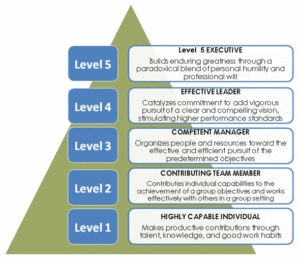 A Level 5 Leader (L5L) is an individual who blends extreme personal humility with intense professional will. The characteristics and success of these leaders were first identified by Jim Collins in 2001 and formed a central plank in his best selling book, ‘From Good to Great’.
A Level 5 Leader (L5L) is an individual who blends extreme personal humility with intense professional will. The characteristics and success of these leaders were first identified by Jim Collins in 2001 and formed a central plank in his best selling book, ‘From Good to Great’.
The Level 5 discovery derived from a research project that Collins began in 1996, when he set out to answer one question: Can a good company become a great company and, if so, how? The answer was the concept of a Level 5 Leader
The L5L sits on top of a hierarchy of capabilities and is, according to Collin’s research, a necessary requirement for transforming an organization from good to great. Individuals do not need to proceed sequentially through each of the lower four levels of the hierarchy to reach the top, but to be a full-fledged L5L requires the capabilities of all the lower levels, plus the special characteristics of Level 5. The characteristics are:
- Level 5 Executive: Builds enduring greatness through a paradoxical combination of personal humility plus professional will.
- Level 4 Effective Leader: Catalyses commitment to and vigorous pursuit of a clear and compelling vision; stimulates the group to high performance standards.
- Level 3 Competent Manager: Organizes people and resources toward the effective and efficient pursuit of predetermined objectives.
- Level 2 Contributing Team Member: Contributes to the achievement of group objectives; works effectively with others in a group setting.
- Level 1 Highly Capable Individual: Makes productive contributions through talent, knowledge, skills, and good work habits.
Particularly in 1971, the concept of Level 5 leadership was (and probably still is) counterintuitive, even countercultural. People generally assumed that transforming companies from good to great required larger-than-life leaders with big personalities like Lee Iacocca, and Jack Welch, who made headlines and become celebrities. And whilst Level 5 leadership is not the only requirement for transforming a good company into a great one, other factors included getting the right people ‘on the bus’ (and the wrong people ‘off the bus’) and creating a culture of discipline; Collins’ research showed L5L to be essential.
40 years later, what’s this got to do with project management?
The answer is project managers run ‘small temporary organisations’; and rather than focusing on being the ‘project management hero’ applying the lessons of Level 5 leadership can take you project from good to great!
Some of the key traits of a L5L are:
- Humility; whenever your team has success, make sure that credit goes to them for their hard work. But a leader, you need to take responsibility for your team’s efforts, particularly when things go wrong.
- Ask for help when you need it. Knowing how to ask for help lets you call upon the expertise of someone stronger in an area than you are. The result? The entire team or organization wins; not just you (See: It’s OK not to know!).
- Take responsibility for your team’s mistakes or failings.
- Be disciplined in your work. When you commit to a course of action, no matter how difficult it is, stick to your resolve. It’s always important to listen to differing opinions, but don’t let fear be your driving motivator when you make, or change, a decision.
- Take the time to finding the right people, and then help them reach their full potential.
- Lead with Passion. When you demonstrate to your team that you love and believe in what you’re doing, they will too.
Striving to be a Level 5 leader is not easy, but rather than being a ‘hero’ fighting to make your project a success, shifting to ‘Level 5’ allows you to be successful and your organisation and your team will benefit.
If you want to become a ‘Level 5 Leader’ there’s more good advice at: https://hbr.org/2005/07/level-5-leadership-the-triumph-of-humility-and-fierce-resolve



Hello,
I work with a school system here in Columbia, SC and am working on our Leaders’ Guide for the 2025-26 school year. In searching for images relative to school leadership, I came across an image on Level 5 Leadership that I would like to use in our guide. May I have permission to do so?